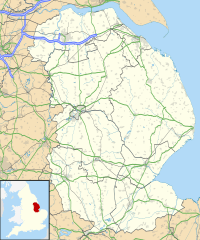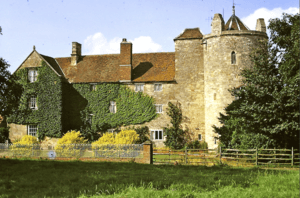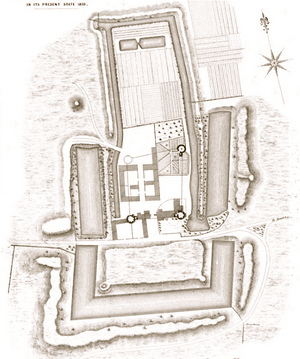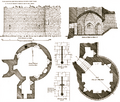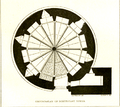Somerton Castle facts for kids
Quick facts for kids Somerton Castle |
|
|---|---|
| Lincolnshire, England | |
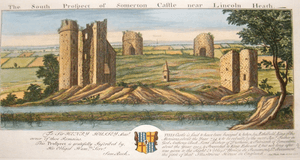
Somerton Castle, engraving by Samuel and Nathaniel Buck
|
|
| Coordinates | 53°07′04″N 0°34′34″W / 53.1177°N 0.5760°W |
| Grid reference | SK9536158739 |
| Site information | |
| Owner | Private |
| Open to the public |
No |
| Site history | |
| Materials | Limestone |
Somerton Castle is an old castle found in Lincolnshire, England. It's about 1 mile (1.6 km) west of a village called Boothby Graffoe. The castle sits on low land between the Lincoln Edge and the River Witham.
A powerful person named Antony Bek probably built the castle in 1281. He later gave it to King Edward II in 1309. One of the most famous events at Somerton Castle was when King John II of France was held prisoner there. This happened between 1359 and 1360, after he was captured in a big battle called the Battle of Poitiers. The castle stayed with the royal family until King Charles I sold it in 1628. Since then, it has been owned by private families.
Contents
Castle History: Medieval Times
Antony Bek got the land for Somerton from his mother. He built the castle after getting special permission in 1281. This permission was called a "licence to crenellate," which meant he could build a castle with defenses like battlements.
In 1309, Bek gave the castle to King Edward II. At that time, the castle was in bad shape. Parts of it, like the great hall and chapel, needed a lot of repair.
Later, in 1330, a military engineer named John Crabbe became the castle's manager. King Edward III visited in 1334, likely to approve repairs. Over the next two years, a lot of money was spent fixing the drawbridge and moat. This was probably when an outer defense area was built to the south of the castle.
An interesting story happened in 1335 or 1336. A noblewoman named Alice de Lacy was kidnapped from her own castle. She was then held at Somerton Castle. She later married her kidnapper, but without the king's permission. So, King Edward III ordered them to be held separately in different towers at Somerton Castle! They eventually got the king's approval to be married.
From 1359 to 1360, King John II of France was held captive here. He had been captured during the Battle of Poitiers. During his time at Somerton, a knight named Sir Saier De Rochford was paid to keep him safe.
By 1393, the castle was again in poor condition. Its walls, gates, towers, and roofs needed a lot of work. In 1408, King Henry VI gave the castle to Sir Ralph Rochford. He spent money to fix the queen's hall and a chapel. The castle was then held by the Dukes of Clarence until 1478. During this time, it was allowed to fall apart even more.
Castle History: Later Years
The castle eventually became part of the lands owned by the Duchy of Lancaster. A survey in 1601 said the castle was "utterly defaced," meaning it was almost completely ruined. However, one of its four towers was still standing tall.
In 1628, the City of London bought the castle from King Charles I. After that, it was owned by the Hussey family. A picture made in 1726 by Samuel Buck shows the castle looking much like it did in 1601.
The castle changed hands several times over the years. In the mid-1970s, the Battersby family sold the castle and its surrounding land.
Around 2010, the castle was in bad shape again. It was put on the "Buildings at Risk" list by English Heritage. This list helps identify important old buildings that need saving. The castle was then bought by Lord GP and Mikey P. Hoare. They hired architects to plan how to fix it up. They also got permission to add a new part to the castle and turn some old farm buildings into homes.
Castle Design and What's Left Today
The design of Somerton Castle seems similar to other castles built in the 1300s and early 1400s. These castles often had moats and rectangular walls with towers at the corners.
Somerton Castle likely had an outer defense area in front of its main gate. This area would have had "open-backed" towers. These towers were designed for cannons or other artillery. The open backs helped let out the smoke from gunpowder. This setup allowed the artillery to fire in many directions, protecting the castle from attacks.
Today, you can still see parts of the old moat around the site. What's left of the castle walls has been built into the current farmhouse. Somerton Castle is considered a very important historical building. It is a Grade I listed building, which means it has special historical or architectural importance.
Images for kids


